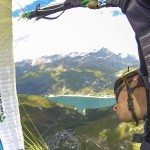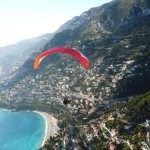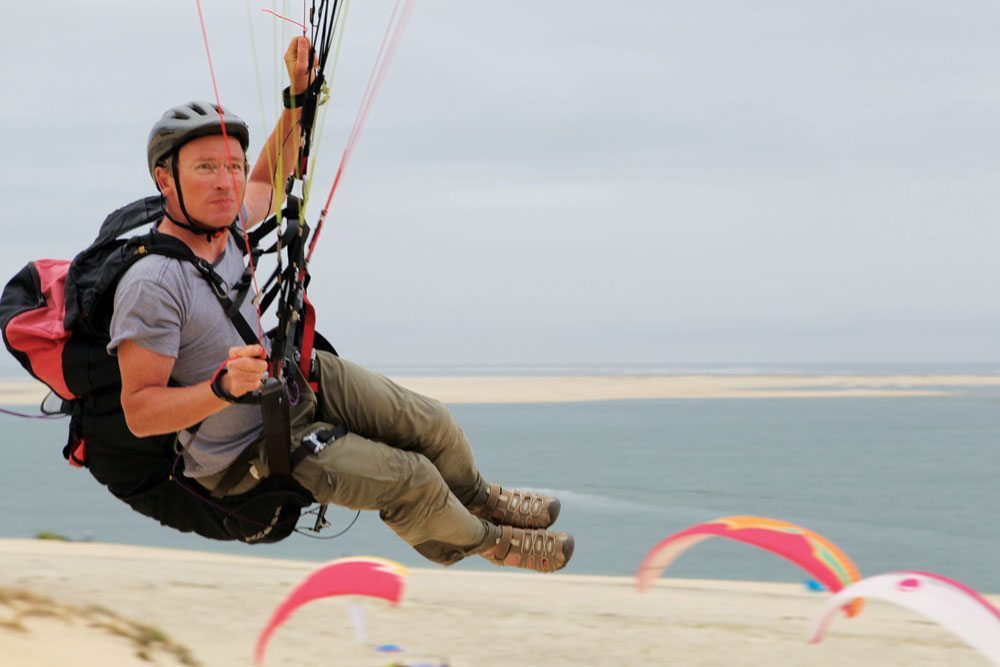
France is a world-class paragliding destination
Paragliding takes you soaring high above some of France’s most stunning landscapes. Take a tandem flight and immediately experience the thrill of high-altitude flying, or train to get your paragliding licence and fly independently. France’s reliable weather conditions and incredible mountainous terrain makes it a world-class destination for paragliding.
There are nearly 750 official FFVL (Fédération Française de Vol Libre) flying sites in France with a concentration in the Alps, Provence and the Pyrenees. All official sites have a wind sock at launch and land and a notice board with contact details for the local paragliding club and rescue services, as well as radio frequencies of emergency services. Before you take off, make sure you familiarise yourself with launch directions, landing approaches, weather conditions and any hazards.
Learn to Paraglide, or Book a Tandem Flight
Our FFVL-endorsed paragliding partners offer tandem flights, paragliding lessons and fly guiding.
[sabai-directory category=paragliding hide_nav=1 perpage=15]
France’s Best Paragliding Sites

Paragliding in the French Alps | Go >
The French Alps is home to some of the best flying sites in Europe. The high mountain terrain and reliable weather create conditions suitable for year round flying. Experienced pilots will appreciate the lift infrastructure in the French Alps ski resorts, which provides easy access to some amazing high-altitude take-off sites. If you’re new to the sport, or considering taking lessons, there are many FFVL endorsed paragliding schools offering everything from tandem flights with a qualified instructor to multi-day instruction and fly-guiding. And, with huge mountains, turquoise lakes and rivers, blue sky and green forested valleys, it’s hard to beat the French Alps for jaw-dropping mountain scenery.

Paragliding in the South of France | Go >
Where the Southern Alps meet the sea, the South of France has world-class flying conditions and ample opportunity to fly year round. Hot sun draws warm air up south-facing slopes creating thermal rockets perfect for epic cross-country paragliding. With the Maritime Alps stretching north from the Med, the coastal mountains of the French Riviera hinterland, the spectacular turquoise lakes of Verdon and the hot, dry mountainous terrain further west towards Mont Ventoux, the south of France is one of the most spectacular flying regions in the world. There’s also a great variety of paragliding, ranging from coastal soaring to cross country and thermal flying, including one of Europe’s premier thermal sites, Le Chalvet in Saint-André-les-Alpes.
Tandem Paragliding Flights
A tandem flight is the easiest way to discover paragliding. By flying with a qualified tandem pilot, pilote biplace, you can experience the thrill of catching thermals and touching cloudbase from your very first flight. You’re positioned in front of your instructor wearing a seat-harness that is attached directly to the paraglider. You play a part in the take off and landing and the pilot will often hand you the controls during the flight. It’s a fantastic experience in itself, but also a superb introduction to the sport if you are thinking about taking lessons and becoming a qualified pilot.
Paragliding Lessons in France
France has over 150 FFVL approved paragliding schools, the majority are based in the Alps, Provence, and the Pyrenees, but there are schools dotted right across the country including the Massif Central and in coastal spots like Arcachon and the Dune du Pilat.
Paragliding schools will offer everything from tandem flights to specific training aimed at advanced pilots. Depending on your level and your ambition, you can take a beginner or intermediate course, get certified, increase your airtime, improve your cross-country record or even try vol-bivouac, multi-day itinerant flying.
Schools are generally pretty flexible with their training programs and lessons may take the form of a 5-day course, an intro-day or weekend, or spread out over a longer period.
The Paragliding Certification Process in France
There are 6 stages in your path to becoming a qualified pilot in France. If you’re familiar with the judo belt sequence, you’ll recognise the colours white through to brown used to distinguish the 6 levels.
White: Introduction to paragliding. Discovery of the equipment and ground handling.
Yellow: Launching and landing. Short hops on a training hill. Understanding wind and turbulance.
Orange: Big solo flights with assistance. Perform 90, 180 and 360 degree turns.
Green: Initial Certificate. Autonomy on a known site in calm conditions.
Blue: Pilote Certificate. Autonomy in varied conditions.
Brown: Pilote Certificate. Autonomy in varied conditions.
Log your progress with the FFVL Pilot’s Passport (English Version)
From the very beginning of your training to become a qualified pilot, for your own safety and that of the pilots around you, you’ll need a solid understanding of the FFVL flying rules and regulations, and particularly visual flight rules, règles du vol à vue.
The French FFVL Licence
Progression through the French system doesn’t tally exactly with the British BHPA. Green stage for example is slightly below the level of Club Pilot and Blue is slightly above.
The medical insurance that comes with the French FFVL Licence covers you for most of the world, even if your country of residence is outside France.
For FFVL qualified pilots flying in the UK, the BHPA (British Hang Gliding and Paragliding Association) recommends you take up BHPA membership as it includes an insurance policy that covers the land owner as well as you the pilot. FFVL insurance only covers the pilot.
To be eligible for BHPA membership, you must pass the appropriate theory exam in order to demonstrate that you understand UK flying regulations. You can make the process easier by requesting that your FFVL school issue you with an IPPI (International Pilot Proficiency Identification) card along with your French licence.
BHPA Paragliding Schools in France
There are a handful of paragliding schools operating full time in France that offer the BHPA route to pilot qualification. The Alpine Flying Centre in Domancy outside Chamonix is the only school to offer both FFVL and BHPA qualifications. Founder, Denis Trott holds a BHPA Senior Instructors license, the French BEES (FFVL) instructors license, and a professional tandem rating.
A BHPA Club Pilot or above is qualified and insured to fly in France.
Fly Guiding
The climate and mountainous geography of the French Alps and southern France makes the region ideal for cross-country flying. Many paragliding schools and private instructors offer fly guiding to qualified pilots wishing to explore the region with the benefit of first-hand local knowledge, whilst improving their XC flying skills. Fly guiding is a great way to experience the best Alpine flying whilst staying safe.
Paragliding Safety Information
Pre-flight checklist:
- Get an up to date weather forecast for the whole day.
- Check in with the local weather stations.
- Ask local pilots for info about the site including the wind, thermals, turbulence and any physical hazards.
- Check site-specific procedures on www.ffvl.fr
- Tell someone your flying plans, launch area and proposed flight path.
- Whenever possible, fly in a group.
- Keep your mobile phone on, it can help to find you in an emergency.
- Visit the landing areas before going up to fly.

